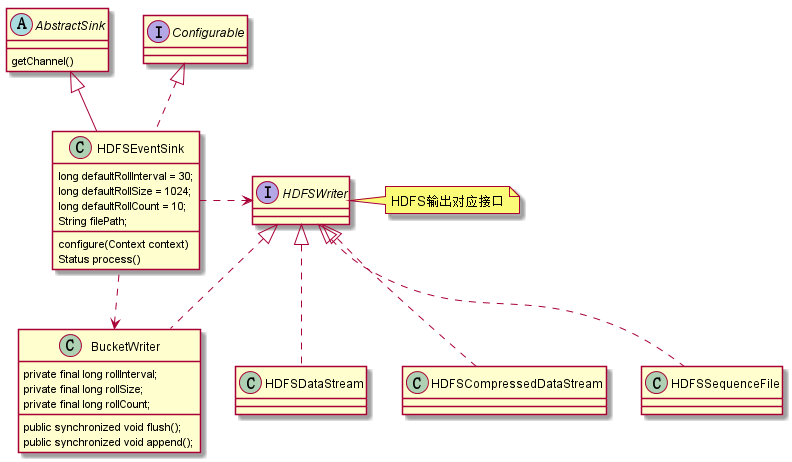HDFSSink組件中,主要由HDFSEventSink,BucketWriter,HDFSWriter幾個類構成。
其中HDFSEventSink主要功能呢是判定Sink的配置條件是否合法,並負責從Channel中獲取events,通過解析event的header信息決定event對應的BucketWriter。
BucketWriter負責按照rollCount,rollSize等條件在HDFS端生成(roll)文件,通過配置文件配置的文件數據格式以及序列化的方式,在每個BucetWriter同一處理。
HDFSWriter作爲接口,其具體實現有HDFSSequenceFile,HDFSDataStream,HDFSCompressedDataStream這三種
HDFSSink功能中關鍵類類圖
HDFSEventSink類
走通HDFSEventSink之前,肯定要對其中配置參數有了解(Flume-HDFSSink配置參數說明)
1、configure()方法中,從配置文件中獲取filePath,fileName等信息,具體參數含義可以參考(Flume-HDFSSink配置參數說明)
2、start()方法,初始化固定大小線程池callTimeoutPool, 週期執行線程池timedRollerPool,以及sfWriters,並啓動sinkCounter
callTimeoutPool
timedRollerPool,週期執行線程池中主要有HDFS文件重命名的線程(根據retryInterval),達到生成文件要求進行roll操作的線程(根據idleTimeout),關閉閒置文件的線程等(rollInterval)
sfWriters sfWriters實際是一個LinkedHashMap的實現類,通過重寫removeEldestEntry方法,將最久未使用的writer移除,保證sfWriters中能夠維護一個固定大小(maxOpenFiles)的最大打開文件數
sinkCounter sink組件監控指標的計數器
3、process() 方法是HDFSEventSink中最主要的邏輯(部分關鍵節點通過註釋寫到代碼中),
process()方法中獲取到Channel,
並按照batchSize大小循環從Channel中獲取event,通過解析event得到event的header等信息,確定該event的HDFS目的路徑以及目的文件名
每個event可能對應不同的bucketWriter和hdfswriter,將每個event添加到相應的writer中
當event個數達到batchSize個數後,writer進行flush,同時提交事務
其中bucketWriter負責生成(roll)文件的方式,處理文件格式以及序列化等邏輯
其中hdfsWriter具體實現有"SequenceFile","DataStream","CompressedStream";三種,用戶根據hdfs.fileType參數確定具體hdfsWriter的實現
public Status process() throws EventDeliveryException {
Channel channel = getChannel(); //調用父類getChannel方法,建立Channel與Sink之間的連接
Transaction transaction = channel.getTransaction();//每次batch提交都建立在一個事務上
transaction.begin();
try {
Set<BucketWriter> writers = new LinkedHashSet<>();
int txnEventCount = 0;
for (txnEventCount = 0; txnEventCount < batchSize; txnEventCount++) {
Event event = channel.take();//從Channel中取出event
if (event == null) {//沒有新的event的時候,則不需要按照batchSize循環取
break;
}
// reconstruct the path name by substituting place holders
// 在配置文件中會有“a1.sinks.k1.hdfs.path = /flume/events/%y-%m-%d/%H%M/%S”這樣的%表示的變量
// 解析配置文件中的變量構造realPath 和 realName
String realPath = BucketPath.escapeString(filePath, event.getHeaders(),
timeZone, needRounding, roundUnit, roundValue, useLocalTime);
String realName = BucketPath.escapeString(fileName, event.getHeaders(),
timeZone, needRounding, roundUnit, roundValue, useLocalTime);
String lookupPath = realPath + DIRECTORY_DELIMITER + realName;
BucketWriter bucketWriter;
HDFSWriter hdfsWriter = null;
WriterCallback closeCallback = new WriterCallback() {
@Override
public void run(String bucketPath) {
LOG.info("Writer callback called.");
synchronized (sfWritersLock) {
sfWriters.remove(bucketPath);//sfWriters以LRU方式維護了一個maxOpenFiles大小的map.始終保持最多打開文件個數
}
}
};
synchronized (sfWritersLock) {
bucketWriter = sfWriters.get(lookupPath);
// we haven't seen this file yet, so open it and cache the handle
if (bucketWriter == null) {
hdfsWriter = writerFactory.getWriter(fileType);//通過工廠獲取文件類型,其中包括"SequenceFile","DataStream","CompressedStream";
bucketWriter = initializeBucketWriter(realPath, realName,
lookupPath, hdfsWriter, closeCallback);
sfWriters.put(lookupPath, bucketWriter);
}
}
// Write the data to HDFS
try {
bucketWriter.append(event);
} catch (BucketClosedException ex) {
LOG.info("Bucket was closed while trying to append, " +
"reinitializing bucket and writing event.");
hdfsWriter = writerFactory.getWriter(fileType);
bucketWriter = initializeBucketWriter(realPath, realName,
lookupPath, hdfsWriter, closeCallback);
synchronized (sfWritersLock) {
sfWriters.put(lookupPath, bucketWriter);
}
bucketWriter.append(event);
}
// track the buckets getting written in this transaction
if (!writers.contains(bucketWriter)) {
writers.add(bucketWriter);
}
}
if (txnEventCount == 0) {
sinkCounter.incrementBatchEmptyCount();
} else if (txnEventCount == batchSize) {
sinkCounter.incrementBatchCompleteCount();
} else {
sinkCounter.incrementBatchUnderflowCount();
}
// flush all pending buckets before committing the transaction
for (BucketWriter bucketWriter : writers) {
bucketWriter.flush();
}
transaction.commit();
if (txnEventCount < 1) {
return Status.BACKOFF;
} else {
sinkCounter.addToEventDrainSuccessCount(txnEventCount);
return Status.READY;
}
} catch (IOException eIO) {
transaction.rollback();
LOG.warn("HDFS IO error", eIO);
return Status.BACKOFF;
} catch (Throwable th) {
transaction.rollback();
LOG.error("process failed", th);
if (th instanceof Error) {
throw (Error) th;
} else {
throw new EventDeliveryException(th);
}
} finally {
transaction.close();
}
}BucketWriter
flush() 方法:
BucketWriter中維護了一個batchCounter,在這個batchCounter大小不爲0的時候會進行doFlush(), doFlush()主要就是對batch中的event進行序列化和輸出流flush操作,最終結果就是將events寫入HDFS中。
如果用戶設置了idleTimeout參數不爲0,在doFlush()操作之後,會往定時執行線程池中添加一個任務,該關閉當前連接HDFS的輸出對象HDFSWriter,執行時間間隔爲idleTimeout,並將這個延遲調度的任務賦值給idleFuture變量。
append()方法:
在介紹flush()方法中,會介紹一個idleFuture變量對應的功能,在append()方法執行前首先會檢查idleFuture任務是否執行完畢,如果沒有執行完成會設置一個超時時間callTimeout等待該進程完成,然後再進行append之後的操作。這樣做主要是爲了防止關閉HdfsWriter的過程中還在往HDFS中append數據,在append一半時候,HdfsWriter關閉了。
之後,在正是append()之前,又要首先檢查當前是否存在HDFSWirter可用於append操作,如果沒有調用open()方法。
每次將event往hdfs中append的時候都需要對rollCount,rollSize兩個參數進行檢查,在滿足這兩個參數條件的情況下,就需要將臨時文件重命名爲(roll)正式的HDFS文件。之後,重新再open一個hdfswriter,往這個hdfswriter中append每個event,當event個數達到batchSize時,進行flush操作。
public synchronized void append(final Event event) throws IOException, InterruptedException {
checkAndThrowInterruptedException();
// idleFuture是ScheduledFuture實例,主要功能關閉當前HDFSWriter,在append event之前需要判斷
// idleFuture是否已經執行完成,否則會造成在append一半的時候 hdfswriter被關閉
if (idleFuture != null) {
idleFuture.cancel(false);
// There is still a small race condition - if the idleFuture is already
// running, interrupting it can cause HDFS close operation to throw -
// so we cannot interrupt it while running. If the future could not be
// cancelled, it is already running - wait for it to finish before
// attempting to write.
if (!idleFuture.isDone()) {
try {
idleFuture.get(callTimeout, TimeUnit.MILLISECONDS);
} catch (TimeoutException ex) {
LOG.warn("Timeout while trying to cancel closing of idle file. Idle" +
" file close may have failed", ex);
} catch (Exception ex) {
LOG.warn("Error while trying to cancel closing of idle file. ", ex);
}
}
idleFuture = null;
}
// If the bucket writer was closed due to roll timeout or idle timeout,
// force a new bucket writer to be created. Roll count and roll size will
// just reuse this one
if (!isOpen) {
if (closed) {
throw new BucketClosedException("This bucket writer was closed and " +
"this handle is thus no longer valid");
}
open();
}
// 檢查rollCount,rollSize兩個roll文件的參數,判斷是否roll出新文件
if (shouldRotate()) {
boolean doRotate = true;
if (isUnderReplicated) {
if (maxConsecUnderReplRotations > 0 &&
consecutiveUnderReplRotateCount >= maxConsecUnderReplRotations) {
doRotate = false;
if (consecutiveUnderReplRotateCount == maxConsecUnderReplRotations) {
LOG.error("Hit max consecutive under-replication rotations ({}); " +
"will not continue rolling files under this path due to " +
"under-replication", maxConsecUnderReplRotations);
}
} else {
LOG.warn("Block Under-replication detected. Rotating file.");
}
consecutiveUnderReplRotateCount++;
} else {
consecutiveUnderReplRotateCount = 0;
}
if (doRotate) {
close();
open();
}
}
// write the event
try {
sinkCounter.incrementEventDrainAttemptCount();// sinkCounter統計metrix
callWithTimeout(new CallRunner<Void>() {
@Override
public Void call() throws Exception {
writer.append(event); //writer是通過配置參數hdfs.fileType創建的HDFSWriter實現
return null;
}
});
} catch (IOException e) {
LOG.warn("Caught IOException writing to HDFSWriter ({}). Closing file (" +
bucketPath + ") and rethrowing exception.",
e.getMessage());
try {
close(true);
} catch (IOException e2) {
LOG.warn("Caught IOException while closing file (" +
bucketPath + "). Exception follows.", e2);
}
throw e;
}
// update statistics
processSize += event.getBody().length;
eventCounter++;
batchCounter++;
if (batchCounter == batchSize) {
flush();
}
}
